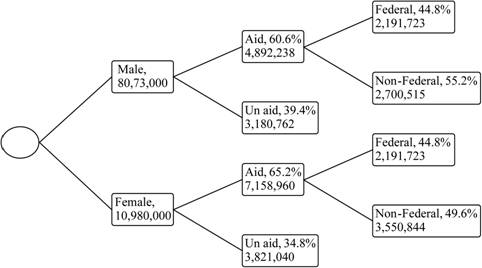
Concept explainers
Student Financial Aid In a recent year 8,073,000 male students and 10,980,000 female students were enrolled as undergraduates. Receiving aid were 60.6% of the male students and 65.2% of the female students. Of those receiving aid, 44.8% of the males got federal aid and 50.4% of the females got federal aid. Choose 1 student at random. (Hint: Make a tree diagram.) Find the
a. A male student without aid
b. A male student, given that the student has aid
c. A female student or a student who receives federal aid
Source: www.nces.gov
a.
To find: The probability that the student is a male student without aid.
Answer to Problem 19E
The probability that the student is a male student without aid is 0.167.
Explanation of Solution
Given info:
There is one student is chosen at random. There are 8,073,000 male students and 10,980,000 female students in which aid were 60.6% of the male students and 65.2% of the female students. Of those receiving aid, 44.8% of the males got federal aid and 50.4% of the females got federal aid.
Calculation:
Multiplication rule for dependent events:
If the events A and B are dependent, the probability of occurring of event B is affected by event A, that is
Let event M denote that student is a male and WOA be denote that selecting student has without aids.
Here, there are 8,073,000 male students and 10,980,000 female students.
Also, the tree diagram is shown below:

The frequency for the class is 8,073,000. Also, the total frequency is,
The formula for probability of event M is,
Substitute 8,073,000 for ‘Frequency for the class’ and 19,053,000 for ‘Total frequencies in the distribution’,
Thus, the probability that the student is a male is 0.424.
Also, from the tree diagram it is observed that the probability that the without aid in male students are 0.394.
By applying multiplication rule, the probability that the student is a male student without aid is,
Thus, the probability that the student is a male student without aid is 0.167.
b.
To find: The probability that the student is a male student, given that the student has aid.
Answer to Problem 19E
The probability that the student is a male student, given that the student has aid is 0.406.
Explanation of Solution
Calculation:
Let event F denote that student is a female and WA be denote that selecting student has with aids.
From the part (a), it is observed that the probability that the student is a male student is 0.424then the probability that the student is a female student is 0.576
From, tree diagram it is observed that the probability that the students has aid in males is 0.606 and the probability that the students has aid in females is 0.652.
By applying multiplication rule, the probability that that the student has aid is,
The required probability is,
Then, the probability that the student is a male student and the student has aid is,
Then, the probability that the student is a male student, given that the student has aid is,
Thus, the probability that the student is a male student, given that the student has aid is 0.406.
c.
To find: The probability that the student is a female student or a student who receives federal aid.
Answer to Problem 19E
The probability that the student is a female student or a student who receives federal aid is 0.691.
Explanation of Solution
Calculation:
Let event FA denote that student has federal aid.
From, part (b) it is observed that the student is a female student is 0.576. Also, from tree graph it is observed that the probability that the student has aid in males is 0.606 and in which federal aids are 0.448. Also, the probability that the student has aid in females is 0.652 and in which federal aids are 0.448.
By applying multiplication rule, the probability that the student has federal aid is,
Then, the probability that the student is a female student and the student has federal aid is,
Addition Rule:
The formula for probability of getting event F or event FA is,
Substitute 0.576 for
Thus, the probability that the student is a female student or a student who receives federal aid is 0.691
Want to see more full solutions like this?
Chapter 4 Solutions
Connect Plus Statistics Hosted by ALEKS Access Card 52 Weeks for Elementary Statistics: A Step-By-St
- Question 2: When John started his first job, his first end-of-year salary was $82,500. In the following years, he received salary raises as shown in the following table. Fill the Table: Fill the following table showing his end-of-year salary for each year. I have already provided the end-of-year salaries for the first three years. Calculate the end-of-year salaries for the remaining years using Excel. (If you Excel answer for the top 3 cells is not the same as the one in the following table, your formula / approach is incorrect) (2 points) Geometric Mean of Salary Raises: Calculate the geometric mean of the salary raises using the percentage figures provided in the second column named “% Raise”. (The geometric mean for this calculation should be nearly identical to the arithmetic mean. If your answer deviates significantly from the mean, it's likely incorrect. 2 points) Starting salary % Raise Raise Salary after raise 75000 10% 7500 82500 82500 4% 3300…arrow_forwardI need help with this problem and an explanation of the solution for the image described below. (Statistics: Engineering Probabilities)arrow_forwardI need help with this problem and an explanation of the solution for the image described below. (Statistics: Engineering Probabilities)arrow_forward
- 310015 K Question 9, 5.2.28-T Part 1 of 4 HW Score: 85.96%, 49 of 57 points Points: 1 Save of 6 Based on a poll, among adults who regret getting tattoos, 28% say that they were too young when they got their tattoos. Assume that six adults who regret getting tattoos are randomly selected, and find the indicated probability. Complete parts (a) through (d) below. a. Find the probability that none of the selected adults say that they were too young to get tattoos. 0.0520 (Round to four decimal places as needed.) Clear all Final check Feb 7 12:47 US Oarrow_forwardhow could the bar graph have been organized differently to make it easier to compare opinion changes within political partiesarrow_forwardDraw a picture of a normal distribution with mean 70 and standard deviation 5.arrow_forward
- What do you guess are the standard deviations of the two distributions in the previous example problem?arrow_forwardPlease answer the questionsarrow_forward30. An individual who has automobile insurance from a certain company is randomly selected. Let Y be the num- ber of moving violations for which the individual was cited during the last 3 years. The pmf of Y isy | 1 2 4 8 16p(y) | .05 .10 .35 .40 .10 a.Compute E(Y).b. Suppose an individual with Y violations incurs a surcharge of $100Y^2. Calculate the expected amount of the surcharge.arrow_forward
- 24. An insurance company offers its policyholders a num- ber of different premium payment options. For a ran- domly selected policyholder, let X = the number of months between successive payments. The cdf of X is as follows: F(x)=0.00 : x < 10.30 : 1≤x<30.40 : 3≤ x < 40.45 : 4≤ x <60.60 : 6≤ x < 121.00 : 12≤ x a. What is the pmf of X?b. Using just the cdf, compute P(3≤ X ≤6) and P(4≤ X).arrow_forward59. At a certain gas station, 40% of the customers use regular gas (A1), 35% use plus gas (A2), and 25% use premium (A3). Of those customers using regular gas, only 30% fill their tanks (event B). Of those customers using plus, 60% fill their tanks, whereas of those using premium, 50% fill their tanks.a. What is the probability that the next customer will request plus gas and fill the tank (A2 B)?b. What is the probability that the next customer fills the tank?c. If the next customer fills the tank, what is the probability that regular gas is requested? Plus? Premium?arrow_forward38. Possible values of X, the number of components in a system submitted for repair that must be replaced, are 1, 2, 3, and 4 with corresponding probabilities .15, .35, .35, and .15, respectively. a. Calculate E(X) and then E(5 - X).b. Would the repair facility be better off charging a flat fee of $75 or else the amount $[150/(5 - X)]? [Note: It is not generally true that E(c/Y) = c/E(Y).]arrow_forward
 College Algebra (MindTap Course List)AlgebraISBN:9781305652231Author:R. David Gustafson, Jeff HughesPublisher:Cengage Learning
College Algebra (MindTap Course List)AlgebraISBN:9781305652231Author:R. David Gustafson, Jeff HughesPublisher:Cengage Learning
 Holt Mcdougal Larson Pre-algebra: Student Edition...AlgebraISBN:9780547587776Author:HOLT MCDOUGALPublisher:HOLT MCDOUGAL
Holt Mcdougal Larson Pre-algebra: Student Edition...AlgebraISBN:9780547587776Author:HOLT MCDOUGALPublisher:HOLT MCDOUGAL Glencoe Algebra 1, Student Edition, 9780079039897...AlgebraISBN:9780079039897Author:CarterPublisher:McGraw Hill
Glencoe Algebra 1, Student Edition, 9780079039897...AlgebraISBN:9780079039897Author:CarterPublisher:McGraw Hill College AlgebraAlgebraISBN:9781305115545Author:James Stewart, Lothar Redlin, Saleem WatsonPublisher:Cengage Learning
College AlgebraAlgebraISBN:9781305115545Author:James Stewart, Lothar Redlin, Saleem WatsonPublisher:Cengage Learning




